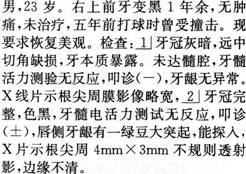共用题干
U. S. Scientists Confirm Water on Mars
NASA scientists said that Mars was covered once by vast lakes,flowing rivers and a Va-riety of other wet environments that had the potential to support life.
Laboratory tests aboard NASA's Phoenix Mars Lander have identified water in a soil sample;the lander's robotic arm delivered the sample Wednesday to an instrument that iden-tifies vapors produced by the heating of samples.
“We have water,”said William Boynton of the University of Arizona,lead scientist for ,the Thermal and Evolved-Gas Analyzer,or TEGA.“This is the first time Martian water has been touched and tasted.”
The robotic arm is a critical part of the Phoenix Mars mission. It is needed to trench into the icy layers of northern polar Mars and deliver samples to instruments that will analyze what Mars is made of,what its water is like,and whether it is or has ever been a possible habitat for life.
The soil sample came from a trench approximately 2 inches deep.When the robotic arm first reached that depth,it hit a hard layer of frozen soil.Two attempts to deliver samples of icy soil on days when fresh material was exposed were foiled when the samples became stuck inside the scoop.Most of the material in Wednesday's sample had been exposed to the air for two days,letting some of the water in the sample vaporize away and making the soil easier to handle.
“Mars is giving us some surprises,”said Phoenix principal investigator Peter Smith of the University of Arizona.“We're excited because surprises are where discoveries come from. One surprise is how the soil is behaving. The ice-rich layers stick to the scoop when poised in the sun above the deck,different from what we expected,from all the Mars simulation tes-ting we've done so far.”
Since landing on May 25,Phoenix has been studying soil with a chemistry lab,TEGA, a microscope,a conductivity probe and cameras.The science team is trying to determine whether the water ice ever thaws enough to be available for biology and if carbon-containing chemicals and other raw materials for life are present.
The mission is examining the sky as well as the ground. A Canadian instrument is using a laser beam to study dust and clouds overhead.
“It's a 30-watt light bulb giving us a laser show on Mars,”said Victoria Hipkin of the Canadian Space Agency.
A full-circle,color panorama of Phoenix's surroundings also has been completed by the spacecraft.
“The details and patterns we see in the ground show an ice-dominated terrain as far as the eye can see,”said Mark Lemmon of Texas A & M University,lead scientist for
Phoenix's Surface Stereo Imager camera.“They help us plan measurements we're making within reach of the robotic arm and interpret those measurements on a wider scale.”
Where are the scientists involved in the research from?
A: They are from America.
B: They are from Canada.
C: They are from both America and Canada.
D: They are from neither America nor Canada.


 正确的诊断是
正确的诊断是 查看材料
查看材料

